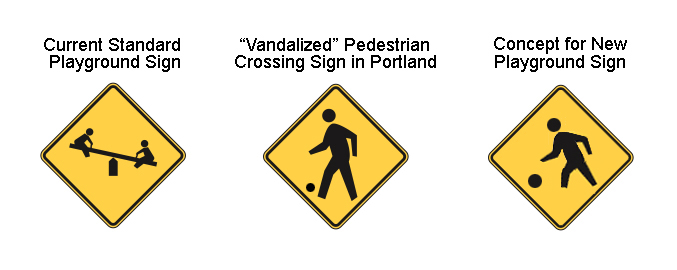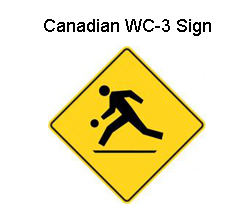
I recently worked with a local parks advocacy group, which requested signs from the New York City Department of Transportation to warn drivers that they were approaching park entrances used by children. The standard sign is the Playground (W15-1) sign, and that was what we specifically requested. DOT installed the signs (along with a complete set of other pedestrian improvements they designed with input from our community). I thought it was great. Then an interesting discussion broke out among community members.
One of the group members commented, "a see saw sign? really?? weren't they all removed years ago?? lol." At first, I didn't understand what she was trying to say. It turned out that her point was that she missed the old play equipment; the see saws had all been removed from the playgrounds long ago. A whole discussion ensued about the safety of teeter totters and an overprotective society. What struck me, though, was that the "see saw sign" is becoming obsolete. As the days of the teeter totter slip further into the past, the image of a see saw may no longer serve well as a visual communication.
This prompted me to recall a sign I had seen in Portland a few months earlier. It was a standard Pedestrian Crossing (W11-2) sign located ahead of a playground. Somebody had altered the sign by scribbling in a black circle, probably using a felt tip marker, which resembled a ball being kicked by the figure on the sign. Thinking about it again, I realized that this informal alteration provides the basis for a better solution.

Not only would a new design inspired by that informal change on a W11-2 sign in Portland address the obsolescence of the W15-1 sign, it would actually communicate the warning much more effectively to drivers. The purpose of the warning sign is to make drivers more alert to the fact that children may suddenly come running into the street. While the "see saw sign" still communicates a general notion that there are children in the area, the image of a child chasing a ball is so much more to the point!

As it turns out, the person in Portland who scribbled the ball onto that sign was not the first to recognize the poignancy of this image. In Canada, the standard playground warning sign already features this basic representation (with the somewhat more clumsy graphic on their WC-3 sign). Adopting the new sign in the United States would not only improve the legibility and effectiveness of the warning, but would also help improve recognition through greater consistency. Perhaps the Canadian sign could even be updated to an improved, new standard, which would be fully consistent on both sides of the border.